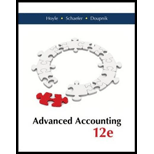
Advanced Accounting - Standalone book
12th Edition
ISBN: 9780077862220
Author: Joe Ben Hoyle, Thomas Schaefer, Timothy Doupnik
Publisher: McGraw-Hill Education
expand_more
expand_more
format_list_bulleted
Question
Chapter 6, Problem 8Q
To determine
Explain why the amount of this adjustment reduced from year to year.
Expert Solution & Answer
Want to see the full answer?
Check out a sample textbook solution
Students have asked these similar questions
Please provide the solution to this general accounting question with accurate accounting calculations.
I need help with this general accounting question using the proper accounting approach.
I Need Solution
Chapter 6 Solutions
Advanced Accounting - Standalone book
Ch. 6 - Prob. 1QCh. 6 - Prob. 2QCh. 6 - When is a firm required to consolidate the...Ch. 6 - Prob. 4QCh. 6 - Prob. 5QCh. 6 - Prob. 6QCh. 6 - Prob. 7QCh. 6 - Prob. 8QCh. 6 - Prob. 9QCh. 6 - Prob. 10Q
Ch. 6 - Prob. 11QCh. 6 - How do noncontrolling interest balances affect the...Ch. 6 - Prob. 13QCh. 6 - Prob. 14QCh. 6 - Prob. 15QCh. 6 - Prob. 16QCh. 6 - Prob. 17QCh. 6 - Prob. 1PCh. 6 - Prob. 2PCh. 6 - Prob. 3PCh. 6 - Prob. 4PCh. 6 - Prob. 5PCh. 6 - Prob. 6PCh. 6 - Prob. 7PCh. 6 - Bens man Corporation is computing EPS. One of its...Ch. 6 - Prob. 9PCh. 6 - Prob. 10PCh. 6 - Prob. 11PCh. 6 - Prob. 12PCh. 6 - Prob. 13PCh. 6 - Prob. 14PCh. 6 - Prob. 15PCh. 6 - On January 1, Coldwater Company has a net book...Ch. 6 - Prob. 17PCh. 6 - Prob. 18PCh. 6 - Prob. 19PCh. 6 - Prob. 20PCh. 6 - Prob. 21PCh. 6 - Prob. 22PCh. 6 - Prob. 23PCh. 6 - Prob. 24PCh. 6 - Prob. 25PCh. 6 - Prob. 26PCh. 6 - Prob. 27PCh. 6 - Prob. 28PCh. 6 - Prob. 29PCh. 6 - Prob. 30PCh. 6 - Prob. 31PCh. 6 - Prob. 32PCh. 6 - Prob. 33PCh. 6 - Prob. 34PCh. 6 - Prob. 35PCh. 6 - Prob. 36PCh. 6 - Prob. 37PCh. 6 - Prob. 38PCh. 6 - Prob. 39PCh. 6 - Prob. 40PCh. 6 - Prob. 41PCh. 6 - Prob. 42PCh. 6 - Prob. 43PCh. 6 - Prob. 44PCh. 6 - Prob. 45PCh. 6 - Prob. 46PCh. 6 - Prob. 47PCh. 6 - Prob. 48PCh. 6 - Prob. 1DYSCh. 6 - Prob. 2DYSCh. 6 - The FASB ASC Subtopic Variable Interest Entities...
Knowledge Booster
Similar questions
- Bruno Manufacturing uses direct labor-hours in its predetermined overhead rate. At the beginning of the year, the total estimated manufacturing overhead was $680,000. At the end of the year, actual direct labor-hours for the year were 42,500 hours, manufacturing overhead for the year was underapplied by $25,500, and the actual manufacturing overhead was $695,000. The predetermined overhead rate for the year must have been closest to: A) $16.00 B) $15.75 C) $16.35 D) $16.94arrow_forwardWhat was manufactured overhead?arrow_forwardWhich of the following choices is the correct status of manufacturing overhead at year-end?arrow_forward
- Morris Corporation applies manufacturing overhead at the rate of $40 per machine hour. Budgeted machine hours for the current period were anticipated to be 200,000; however, higher than expected production resulted in actual machine hours worked of 225,000. Budgeted and actual manufacturing overhead figures for the year were $8,000,000 and $8,750,000, respectively. On the basis of this information, the company's year-end overhead was: A. overapplied by $250,000 B. underapplied by $250,000 C. overapplied by $750,000 D. underapplied by $750,000arrow_forwardAt the beginning of the year, manufacturing overhead for the year was estimated to be $560,000. At the end of the year, actual labor hours for the year were 35,000 hours, the actual manufacturing overhead for the year was $590,000, and the manufacturing overhead for the year was underapplied by $30,000. If the predetermined overhead rate is based on direct labor hours, then the estimated labor hours at the beginning of the year used in the predetermined overhead rate must have been ___ hours.arrow_forwardGive me Answerarrow_forward
arrow_back_ios
SEE MORE QUESTIONS
arrow_forward_ios
Recommended textbooks for you
 Auditing: A Risk Based-Approach (MindTap Course L...AccountingISBN:9781337619455Author:Karla M Johnstone, Audrey A. Gramling, Larry E. RittenbergPublisher:Cengage Learning
Auditing: A Risk Based-Approach (MindTap Course L...AccountingISBN:9781337619455Author:Karla M Johnstone, Audrey A. Gramling, Larry E. RittenbergPublisher:Cengage Learning Financial Reporting, Financial Statement Analysis...FinanceISBN:9781285190907Author:James M. Wahlen, Stephen P. Baginski, Mark BradshawPublisher:Cengage Learning
Financial Reporting, Financial Statement Analysis...FinanceISBN:9781285190907Author:James M. Wahlen, Stephen P. Baginski, Mark BradshawPublisher:Cengage Learning Intermediate Accounting: Reporting And AnalysisAccountingISBN:9781337788281Author:James M. Wahlen, Jefferson P. Jones, Donald PagachPublisher:Cengage Learning
Intermediate Accounting: Reporting And AnalysisAccountingISBN:9781337788281Author:James M. Wahlen, Jefferson P. Jones, Donald PagachPublisher:Cengage Learning

Auditing: A Risk Based-Approach (MindTap Course L...
Accounting
ISBN:9781337619455
Author:Karla M Johnstone, Audrey A. Gramling, Larry E. Rittenberg
Publisher:Cengage Learning

Financial Reporting, Financial Statement Analysis...
Finance
ISBN:9781285190907
Author:James M. Wahlen, Stephen P. Baginski, Mark Bradshaw
Publisher:Cengage Learning

Intermediate Accounting: Reporting And Analysis
Accounting
ISBN:9781337788281
Author:James M. Wahlen, Jefferson P. Jones, Donald Pagach
Publisher:Cengage Learning